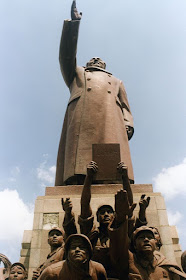 |
| Mount Olympus |
Traditionally, the mountain is a symbol of the divine. It is the place where God dwells and the locus of encounter with God. Practically all ancient cultures and civilizations conceive of the mountain in this way. The journey up the mountain is difficult, a struggle.
This Greek poem of the Classical period envisions the mountain as the habitation of a universally attributed aspect of divine being: beauty. The exposition is lyrical, terse, enduring.
http://www.marxists.org/reference/archive/mao/selected-works/poems/poems17.htm
—Mao Zhedong, “Mount Liupan,” Marxist Internet Archive: Mao Zhedong
Mao’s Road to Power: Revolutionary Writings: 1912-1949, Volume 5, Stuart R. Schram and Nancy J. Hodes, eds. (New York: M. E. Sharpe, 1992) contains commentary that explains the figures of speech in the poem, for example, on page 33:
begin
5. Traditional legend has it that during Han Wudi’s time, an army was sent out to Southern Yue. They asked Wudi for a long cord, promising to bind up and bring back the king of Yue.
6. “Gray Dragon” stands for the planet Jupiter, which is considered an ill-omened, evil force in ancient Chinese lore. Chinese commentaries on this poem state that it refers to Chiang Kaishek, although earlier translations of the poem have indicated that it may also stand for the Japanese invaders. The editors of the Shici duilian also state that this line alludes to a ci to the tune “Congratulating the Bridegroom” by the Song dynasty poet Liu Kezbuang, which contains the line “When will the long cord come into our hands/To bind fast the military commander?”
end
Mao Zhedong’s poem represents the mountain not as a symbol of the spiritual quest but rather of the victory of Communist revolution. The author is the Great Helmsman, responsible for founding the modern Communist republic of China, ending decades of wracked political turmoil, and for tens of millions of deaths under an oppressive absolutist regime. Deep irony indeed that the cause of so much carnage should be conceived of in terms of a symbol of the transcendent.
 |
|
“Ozymandias”
|
—Olav H. Hauge, “Up on Top,” transl. by Robert Bly, Poetry (April 2008)
This poem about the mountain turns the motif on its head. Mountains are “foolishness and arrogance,” you climb them to get “up on top” of a “dump.” At the summit awaits jaded disillusion, symbolized by a pot overturned: “The pot lies upside down in the hearth, / it sprawls with hostile black feet.”

PHOTO CREDITS
ReplyDeleteMount Olympus photo courtesy of FishSpeaker
Photo link:
https://commons.wikimedia.org/wiki/File:Mount_Olympus_-_panoramio.jpg
Long Live the Victory of Mao Zedong Thought (1970) photo courtesy of Noel Hanna
Photo link:
https://en.wikipedia.org/wiki/Long_Live_the_Victory_of_Mao_Zedong_Thought#/media/File:Mao_Zedong_Statue_in_North_China.jpg
“Ozymandias” photo courtesy of katieandtommy
Photo link:
https://www.flickr.com/photos/katieandtommy/2267784562/
Gonzalinho
The broken statue of Ramses II at Luxor, Egypt is believed to have been the inspiration for Percy Bysshe Shelley’s poem “Ozymandias.”
ReplyDeleteGonzalinho
Except for works in the public domain, the poems reproduced here are shown according to principles of fair use, that is, for the purposes of analysis and commentary.
ReplyDeleteGonzalinho